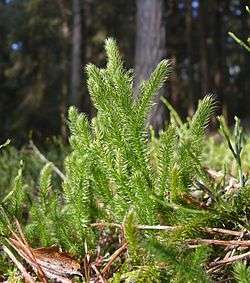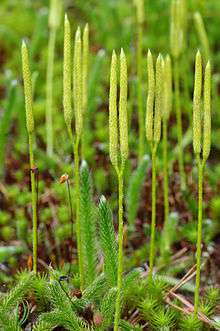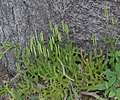Lycopodium clavatum
Lycopodium clavatum (common club moss,[3][4] stag's-horn clubmoss,[5] running clubmoss,[6] or ground pine[7]) is the most widespread species in the genus Lycopodium in the clubmoss family.
| Lycopodium clavatum | |
|---|---|
 | |
| Scientific classification | |
| Kingdom: | Plantae |
| Clade: | Tracheophytes |
| Clade: | Lycophytes |
| Class: | Lycopodiopsida |
| Order: | Lycopodiales |
| Family: | Lycopodiaceae |
| Genus: | Lycopodium |
| Species: | L. clavatum |
| Binomial name | |
| Lycopodium clavatum | |
| Synonyms[1][2] | |
|
Synonymy
| |
Description
Lycopodium clavatum is a spore-bearing vascular plant, growing mainly prostrate along the ground with stems up to 1 m (39 in) long; the stems are much branched, and densely clothed with small, spirally arranged microphyll leaves. The leaves are 3–5 mm long and 0.7–1 mm broad, tapered to a fine hair-like white point. The branches bearing strobili or spore cones turn erect, reaching 5–15 cm (2.0–5.9 in) above ground, and their leaves are modified as sporophylls that enclose the spore capsules or sporangia. The spore cones are yellow-green, 2–3 cm (0.79–1.18 in) long, and 5 mm (0.20 in) broad. The horizontal stems produce roots at frequent intervals along their length, allowing the stem to grow indefinitely along the ground. The stems superficially resemble small seedlings of coniferous trees, though it is not related to these.

Distribution
Lycopodium clavatum has a widespread distribution across several continents.[8][9][10][11][12][13] There are distinct subspecies and varieties in different parts of its range:
- Lycopodium clavatum subsp. clavatum
- Lycopodium clavatum subsp. clavatum var. clavatum (Europe, Asia, North America)
- Lycopodium clavatum subsp. clavatum var. aristatum (Mexico, Caribbean, Central America, northern South America south to northern Argentina)
- Lycopodium clavatum subsp. clavatum var. asiaticum (Japan, northeast China)
- Lycopodium clavatum subsp. clavatum var. borbonicum (central and southern Africa)
- Lycopodium clavatum subsp. clavatum var. kiboanum (mountains of tropical Africa)
- Lycopodium clavatum subsp. contiguum (southern Central America, northern South America; syn. Lycopodium contiguum)
Although globally widespread, like many clubmosses, it is confined to undisturbed sites, disappearing from farmed areas and sites with regular burning. As a result, it is endangered in many areas. In the UK it is one of 101 species named as a high priority for conservation by the wild plant charity Plantlife.
- Other common names
Common names for this species include wolf's-foot clubmoss, common clubmoss, wolf-paw clubmoss, running ground-pine, running pine,[7] running moss, princess pine, and others.
- Use
The spores of this moss, "lycopodium powder", are explosive if present in the air in high enough densities. They were used as flash powder in early photography and magic acts.
- Active constituents
Bioactive secondary metabolites in clubmosses include triterpenoids with acetylcholinesterase inhibitor activity isolated from this species.[14]
 L. clavatum ssp. clavatum var. clavatum, with strobili
L. clavatum ssp. clavatum var. clavatum, with strobili L. clavatum with strobili
L. clavatum with strobili
References
- The Plant List, Lycopodium clavatum L.
- "Family Lycopodiaceae, genus Lycopodium; world species list". Archived from the original on 2009-02-27. Retrieved 2015-07-27.
- "Lycopodium clavatum (common clubmoss, running clubmoss): Go Botany". gobotany.nativeplanttrust.org. Retrieved 2019-05-29.
- "Licopodio, Lycopodium clavatum, Common club moss: Philippine herbal medicines / Stuartxchange". www.stuartxchange.org. Retrieved 2019-05-29.
- "BSBI List 2007". Botanical Society of Britain and Ireland. Archived from the original (xls) on 2014-10-23. Retrieved 2014-10-17.
- "Lycopodium clavatum". Natural Resources Conservation Service PLANTS Database. USDA. Retrieved 26 July 2016.
- Bailey, L.H.; Bailey, E.Z.; the staff of the Liberty Hyde Bailey Hortorium. 1976. Hortus third: A concise dictionary of plants cultivated in the United States and Canada. Macmillan, New York.
- "Lycopodium clavatum in Flora of North America @ efloras.org". www.efloras.org. Retrieved 2019-05-29.
- "Lycopodium clavatum in Flora of China @ efloras.org". www.efloras.org. Retrieved 2019-05-29.
- Altervista Flora Italiana, Lycopodium clavatum L. includes photos and European distribution map
- Jørgensen, P. M., M. H. Nee & S. G. Beck. (eds.) 2014. Catálogo de las plantas vasculares de Bolivia, Monographs in systematic botany from the Missouri Botanical Garden 127(1–2): i–viii, 1–1744. Missouri Botanical Garden Press, St. Louis
- Mickel, J. T. & J. M. Beitel. 1988. Pteridophyte Flora of Oaxaca, Mexico. Memoirs of The New York Botanical Garden 46: 1–568
- Gibbs Russell, G. E., W. G. M. Welman, E. Retief, K. L. Immelman, G. Germishuizen, B. J. Pienaar, M. Van Wyk & A. Nicholas. 1987. List of species of southern African plants. Memoirs of the Botanical Survey of South Africa 2(1–2): 1–152(pt. 1), 1–270(pt. 2).
- Rollinger JM, Ewelt J, Seger C, Sturm S, Ellmerer EP, Stuppner H (2005). Planta Med;71(11):1040-3. PMID 16320206
External links
- Lycopodium clavatum, running ground pine, Flora, fauna, earth, and sky...The natural history of the northwoods
- Bioimagesphotos
- Jepson Manual Treatment, University of California
- Calphotos Photo gallery, University of California
- photo of herbarium specimen at Missouri Botanical Garden, collected in Dominican Republic in 1967
| Wikimedia Commons has media related to Lycopodium clavatum. |
